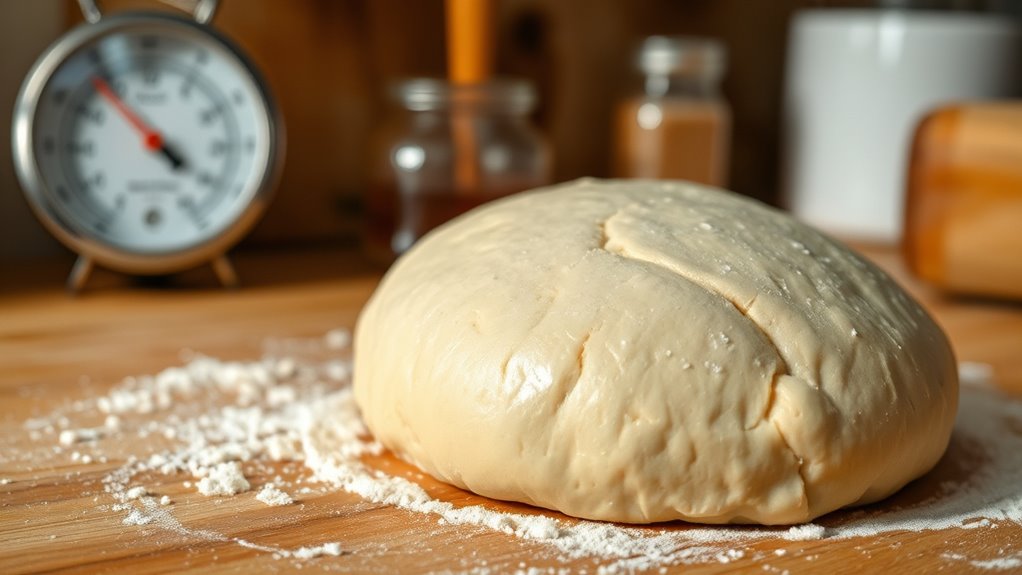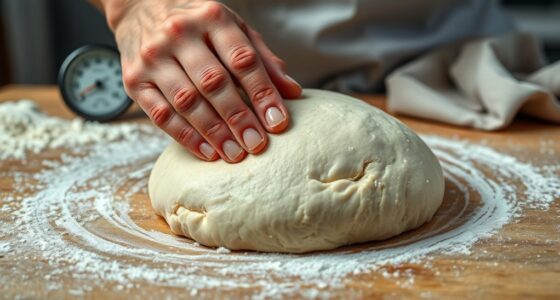To build confidence in handling dough, understand how humidity affects moisture and elasticity. In humid environments, you may need less water, as dough tends to be wetter, while in dry conditions, add a bit more to prevent dryness. Keep an eye on signs like stickiness or toughness, and adjust your ingredients accordingly. Managing your environment and using the right tools helps maintain consistency. Keep exploring, and you’ll gain access to even more tips for perfect baking every time.
Key Takeaways
- Humidity influences dough moisture, elasticity, fermentation speed, and gluten development, requiring adjustments in water content.
- Recognize signs of humidity-related issues such as stickiness, dryness, slow fermentation, or dense texture.
- Adjust flour and liquid ratios based on ambient humidity to maintain consistent dough consistency.
- Control environment humidity with tools like humidifiers or dehumidifiers and use moisture-resistant ingredients and tools.
- Use practical techniques such as covering dough, resting, and environment management to optimize dough behavior in various humidity conditions.
Understanding the Role of Humidity in Baking
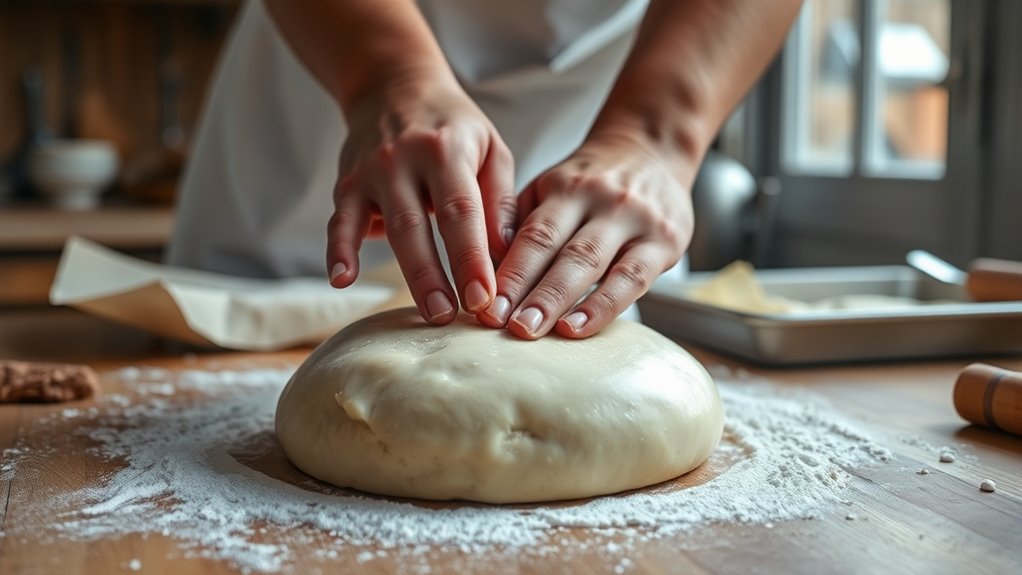
Humidity plays a crucial role in baking because it directly affects how dough behaves during mixing and rising. When humidity fluctuates, it impacts moisture management, making it harder to predict dough consistency. High humidity levels can cause dough to become overly sticky, while low humidity can dry it out quickly. These variations influence how ingredients combine and how the dough develops gluten. To maintain consistent results, you need to adjust your techniques based on current humidity conditions. Monitoring the environment helps you add water or flour as needed, ensuring your dough remains at the right moisture level. Understanding these humidity fluctuations allows you to control moisture effectively, leading to better fermentation, improved texture, and more reliable baking outcomes. Additionally, being aware of humidity’s impact on baking can help you troubleshoot common issues and refine your baking process.
How Humidity Affects Dough Consistency and Texture
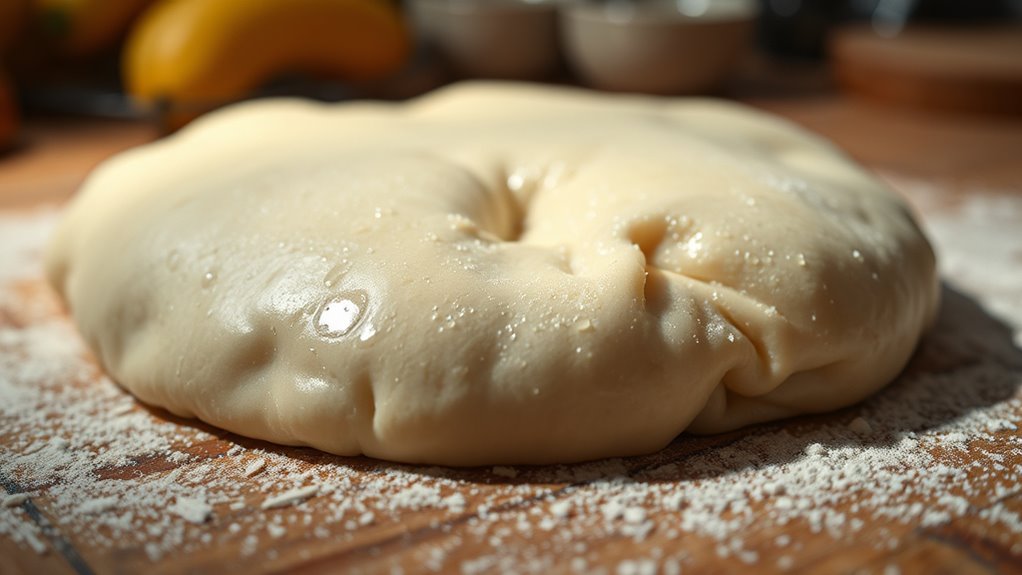
When the moisture levels in the air change, they directly influence your dough’s texture and consistency. Higher humidity makes the dough more pliable, increasing dough elasticity and allowing it to stretch easily. Conversely, low humidity causes the dough to dry out, resulting in a tougher texture. Additionally, humidity impacts fermentation speed: in humid environments, yeast activates faster, accelerating rising times. Conversely, drier air slows fermentation, which can affect the dough’s overall development. To optimize your dough, keep these factors in mind:
- Adjust water content based on humidity levels to maintain proper consistency.
- Monitor dough elasticity to prevent over- or under-stretching.
- Be aware that fermentation speed varies, requiring timing adjustments.
- Using standard operating procedures (SOPs) can help maintain consistent dough quality despite humidity fluctuations.
Understanding these effects helps you achieve the perfect texture every time.
Identifying Signs of Humidity-Related Dough Issues
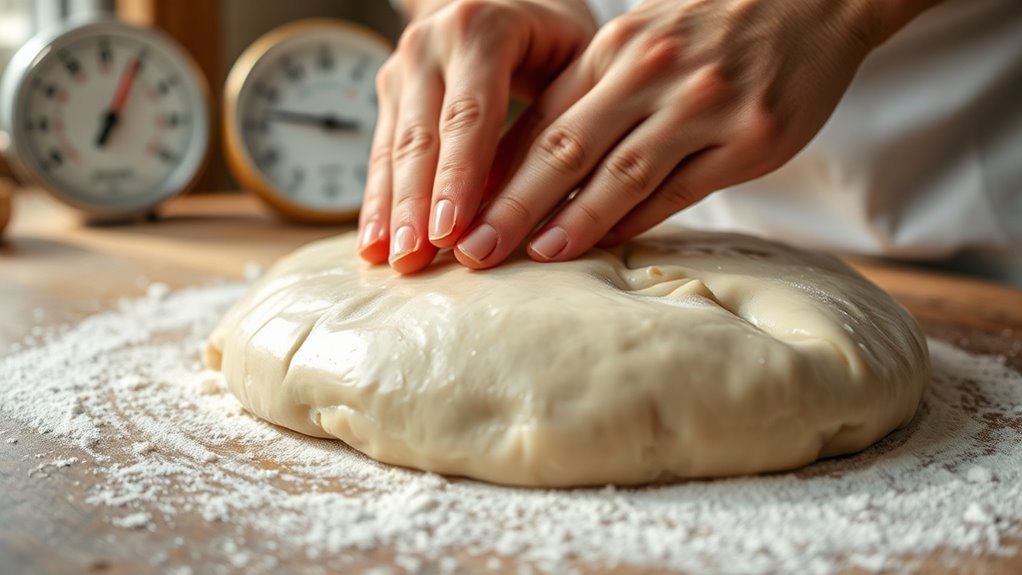
If your dough isn’t behaving as expected, it’s likely showing signs of humidity-related issues. You might notice sluggish dough fermentation or unusually slow yeast activity, indicating moisture imbalance. Conversely, overly sticky dough that spreads or refuses to hold shape suggests excess humidity. Here’s a quick guide to signs:
| Sign | What it Means |
|---|---|
| Slow rising or no fermentation | Low humidity hampers yeast activity |
| Sticky, difficult handling | Too much moisture in the environment |
| Excessive spreading | Humidity causes weak gluten structure |
| Dense, heavy texture | Poor fermentation due to moisture issues |
| Unusual sour smell | Yeast activity might be affected by humidity |
Recognizing these signs helps you troubleshoot humidity’s impact on your dough. For optimal baking results, controlling your environment’s humidity levels can be just as important as ingredients and technique.
Adjusting Flour and Liquid Ratios Based on Air Moisture
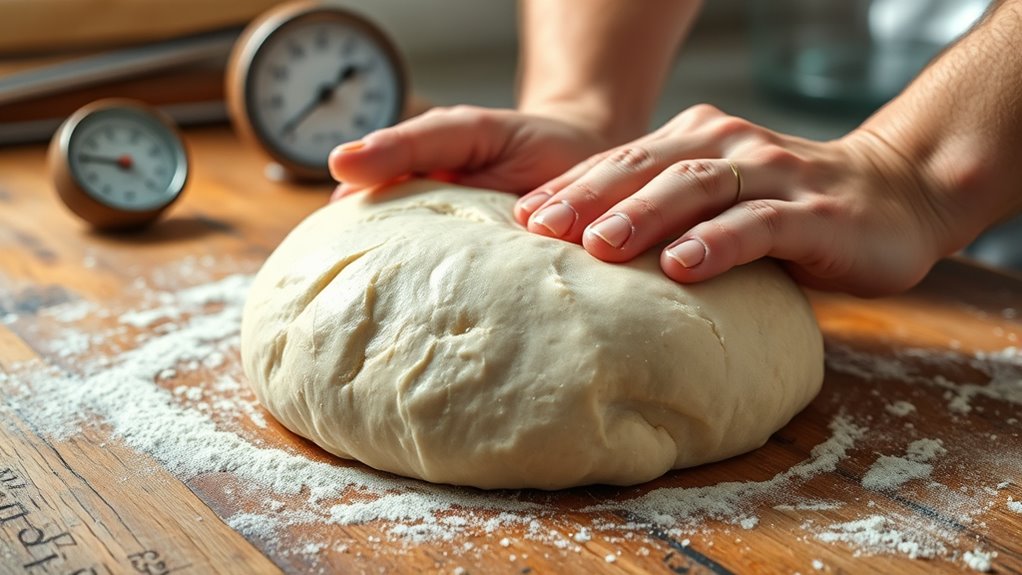
When humidity levels change, the amount of flour your dough absorbs can vary considerably. You’ll need to adjust your liquid amounts to maintain proper dough consistency, especially in high or low moisture conditions. Keep a close eye on the dough’s texture to guarantee it’s neither too dry nor too sticky. Incorporating natural materials like linen or wood in your baking environment can also influence moisture retention and dough behavior.
Flour Absorption Variability
Air moisture levels directly influence how much flour absorbs liquids during dough preparation. This flour absorption varies with moisture variability, meaning you may need to adjust recipes depending on the environment.
To manage this, consider these steps:
- Monitor your dough’s consistency closely—if it feels dry, it needs more liquid; if too sticky, use less.
- Keep notes of humidity levels and how your flour responds, creating a personalized guide for future baking.
- Recognize that different flours react uniquely to moisture variability, so adapt your approach accordingly.
Understanding flour absorption helps you maintain the right dough texture regardless of air moisture. Adjustments based on moisture variability ensure your baking results stay consistent, even with fluctuating humidity.
Adjusting Hydration Levels
Adjusting hydration levels is essential for achieving the perfect dough, especially as air moisture fluctuates. When humidity drops, your dough may need more water to maintain proper moisture, while high humidity can require less to prevent it from becoming too sticky. Hydration adjustments involve fine-tuning the flour and liquid ratios based on current air moisture, ensuring ideal dough consistency. Moisture management becomes vital in these situations, allowing you to adapt quickly and avoid over- or under-hydration. Keep a close eye on your environment and be ready to add small amounts of water or flour as needed. This proactive approach helps you achieve the ideal dough texture and elasticity, regardless of changing humidity levels. Proper hydration adjustments are key to consistent, high-quality baking results. Environmental factors can significantly influence how your dough behaves during mixing and fermentation, so staying aware of these conditions is crucial.
Monitoring Dough Consistency
Monitoring dough consistency requires you to actively observe how your dough feels and responds during mixing and shaping. Pay attention to dough elasticity, which indicates proper gluten development, and adjust hydration if it’s too stiff or sticky. Changes in air moisture influence fermentation speed, so you need to adapt your flour and liquid ratios accordingly. Incorporating space and organization strategies, such as creating designated zones for dough preparation, can also streamline your process and improve results.
Consistent monitoring helps you maintain ideal dough texture and fermentation, regardless of air moisture fluctuations.
Techniques for Managing Humidity in Your Baking Environment
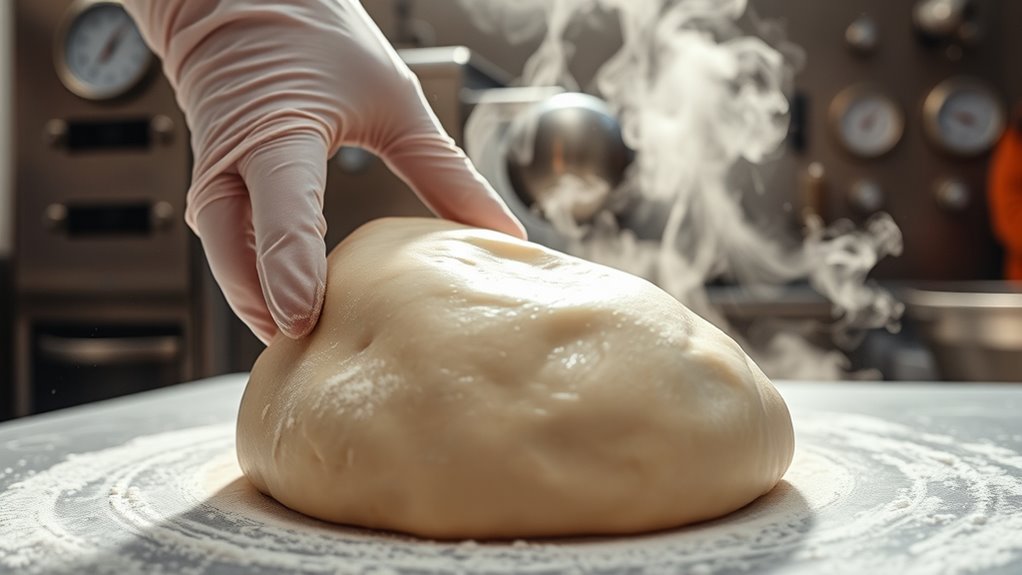
Managing humidity in your baking space is key to consistent results. You can adjust dough hydration, control ambient moisture, or use humidity chambers to create ideal conditions. These techniques help you maintain optimal dough behavior regardless of outside weather. Incorporating sound design principles such as ambient sound control can also help create a stable environment for your baking operations.
Adjusting Hydration Levels
When humidity levels fluctuate, you can modify your dough’s hydration to guarantee it still performs well. Hydration adjustment is key to maintaining consistent dough behavior despite moisture changes. To manage moisture effectively, try these techniques:
- Increase water content if the environment is dry, ensuring the dough remains pliable and elastic.
- Reduce water when humidity is high, preventing the dough from becoming sticky or overly loose.
- Adjust gradually, testing small batches to find the perfect balance for your specific conditions.
- Incorporating hydration levels into your baking routine can help you better understand how moisture impacts dough consistency and performance.
These steps help you master moisture management and keep your dough reliable. Remember, slight tweaks in hydration can markedly improve handling and final texture, especially when humidity shifts unexpectedly.
Controlling Ambient Moisture
Ever wondered how to keep your baking environment consistently humid or dry? Proper humidity regulation is key to reliable dough behavior. To manage moisture control, consider tools like humidifiers or dehumidifiers, depending on your needs. Adjusting your workspace’s temperature and airflow also influences ambient moisture levels. Use the table below to understand how different methods impact humidity:
| Method | Effect on Humidity |
|---|---|
| Humidifier | Increases moisture |
| Dehumidifier | Decreases moisture |
| Open windows | Variable, depends on climate |
| Airflow management | Controls moisture dispersion |
| Covering dough | Prevents moisture loss |
Controlling ambient moisture ensures consistent dough handling and baking results. Regularly monitor your environment to fine-tune humidity regulation effectively. Additionally, understanding the contrast ratio of your equipment can help you optimize your workspace lighting for better visibility and precision during baking.
Using Humidity Chambers
Using humidity chambers offers a precise way to control moisture levels in your baking environment. They help maintain consistent dough hydration, ensuring reliable results. To effectively use humidity chambers, 1. Set the chamber’s humidity level based on your dough’s hydration needs, typically between 75-85% for high hydration doughs. 2. Place your dough inside, avoiding direct contact with water or surfaces that could alter moisture content. 3. Regularly monitor and adjust the chamber’s humidity to prevent over-drying or excess moisture, which can affect gluten development and rise. Proper storage of ingredients is also essential to maintain overall freshness and quality.
Using Humidity-Resistant Ingredients and Tools

To maintain consistent dough behavior in humid conditions, you should choose ingredients and tools specifically designed to withstand moisture. Humidity-resistant ingredients, like stabilized flour or pre-measured mixes, offer better ingredient stability and a longer shelf life, reducing the risk of spoilage or clumping. Use airtight storage containers and tools made from moisture-proof materials to prevent absorption of excess humidity. These choices help keep your ingredients dry and consistent, ensuring predictable results. Investing in quality measuring tools with moisture-resistant coatings can also improve accuracy. By selecting the right ingredients and tools, you minimize variability caused by humidity, allowing your dough to behave reliably regardless of environmental changes. This approach helps you maintain confidence, especially when working in fluctuating humidity levels.
Practical Tips for Baking in High Humidity Conditions
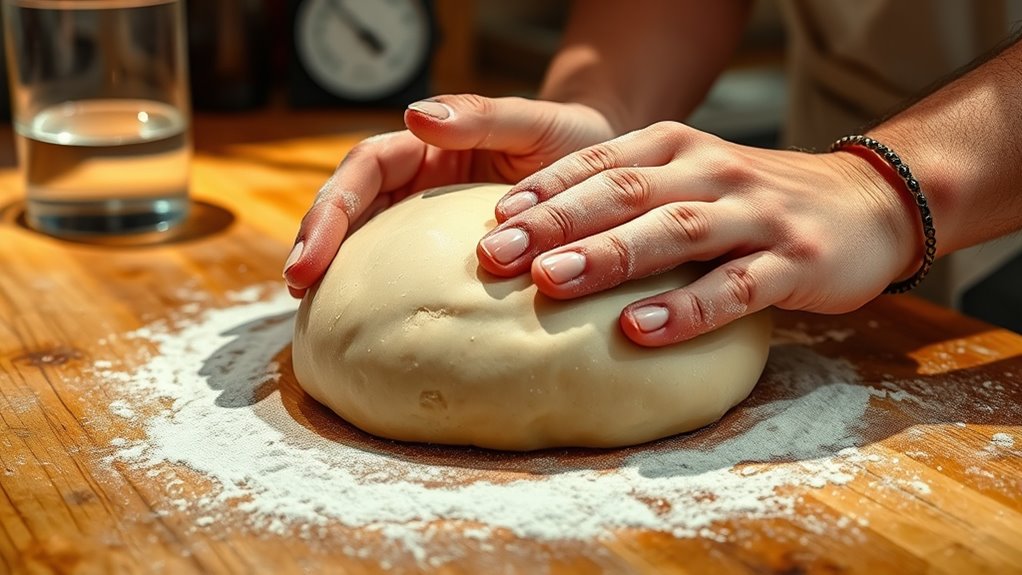
When baking in high humidity, you need to adjust your techniques to prevent dough from becoming overly sticky or difficult to handle. Artificial humidity can interfere with gluten development, making dough softer and harder to work with. To overcome this, try these tips:
In high humidity, adjust water and flour to keep dough manageable and prevent excessive stickiness.
- Reduce the amount of water in your recipe slightly to counteract excess moisture.
- Use less flour during kneading to prevent the dough from sticking excessively.
- Incorporate a resting period to allow gluten to strengthen, helping the dough maintain structure despite the humidity.
These adjustments help control dough consistency, ensuring successful baking. By understanding how humidity impacts gluten development, you can adapt your process and achieve better results, even in moist conditions.
Tips for Baking in Dry, Low-Humidity Environments
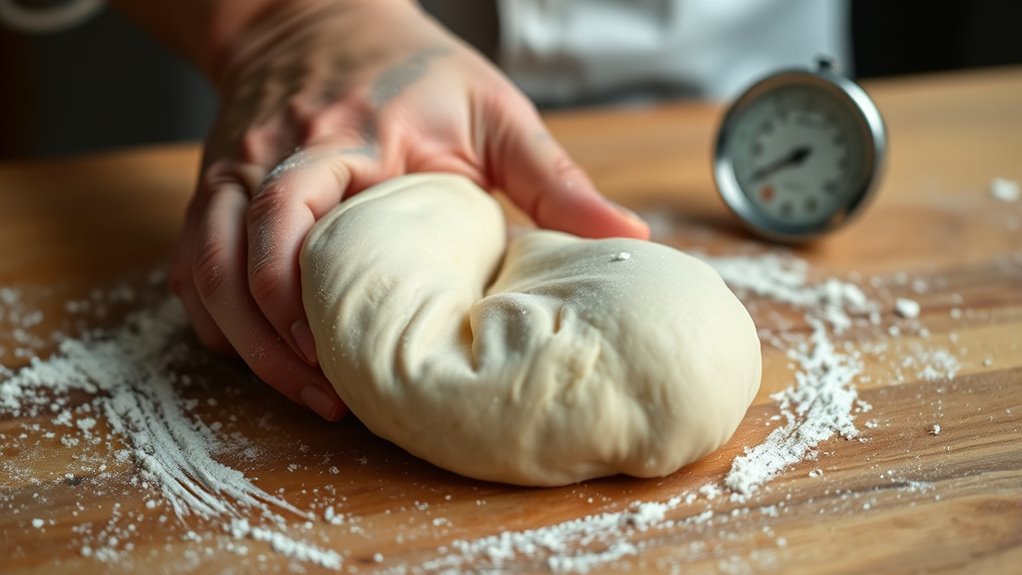
In dry, low-humidity environments, your dough can quickly become too dry and stiff, making it difficult to knead and shape. To combat this, improve air circulation in your workspace to prevent uneven drying. Keep the temperature controlled; warmer air can help maintain moisture levels, but avoid overheating, which accelerates drying. Cover your dough with a damp cloth or plastic wrap during proofing to trap humidity and prevent surface dryness. Use a dough scraper to handle stiff dough more easily, and consider adding a small amount of water or oil if the dough feels too crumbly. Regularly monitoring airflow and temperature helps maintain a more consistent environment, ensuring your dough stays moist, pliable, and easier to work with despite the dry conditions.
Monitoring and Controlling Humidity for Consistent Results
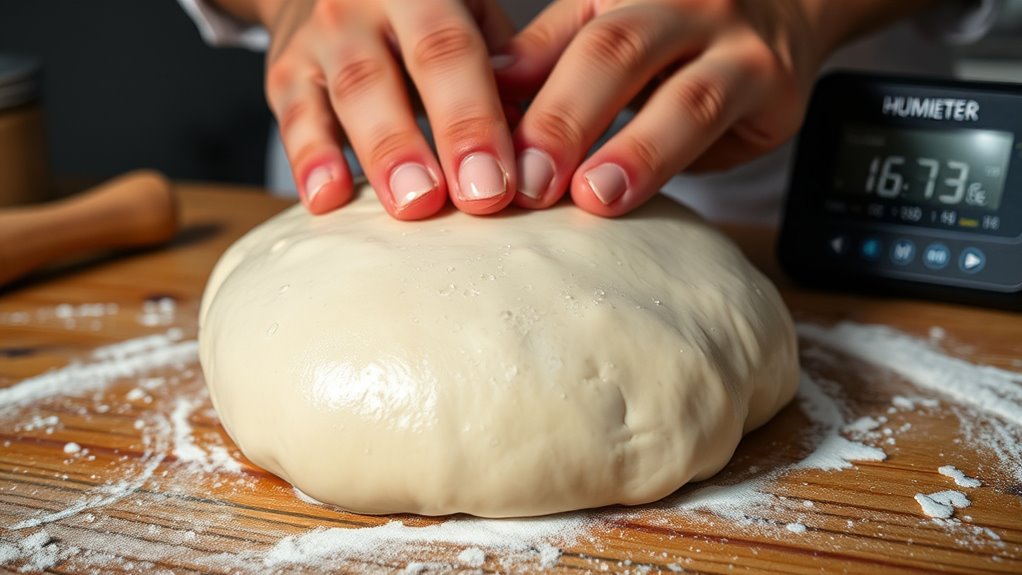
Maintaining consistent humidity levels is essential for predictable dough behavior, and actively monitoring your environment helps you achieve this. Use humidity sensors to track moisture levels accurately, ensuring your workspace stays within ideal ranges. To control humidity effectively, consider these steps:
- Install reliable humidity sensors in your baking area to get real-time data.
- Use moisture barriers around your workspace or proofing boxes to prevent unwanted fluctuations.
- Adjust environmental conditions by adding humidifiers or dehumidifiers based on sensor readings.
Consistent monitoring allows you to respond quickly to changes, maintaining ideal dough conditions. Implementing moisture barriers minimizes external influences, leading to more reliable results. Regularly check your sensors and barriers to keep everything functioning smoothly, ensuring your dough behaves just as you want every time.
Frequently Asked Questions
How Does Humidity Influence Yeast Activity During Proofing?
Humidity directly impacts yeast activation during proofing by creating an ideal environment for fermentation. In a humid proofing environment, moisture helps yeast thrive, speeding up dough rise. Low humidity can slow yeast activity, leading to a denser loaf. You should monitor humidity levels carefully, adjusting as needed to guarantee your dough proves perfectly. Proper humidity keeps the dough moist and promotes suitable yeast activity for a light, airy bread.
Can Humidity Levels Affect the Gluten Development Process?
Yes, humidity levels impact gluten development through hydration control and flour absorption. When humidity is high, the dough absorbs more moisture, leading to better gluten formation and elasticity. Conversely, low humidity causes the flour to absorb less, making it harder to develop a strong gluten network. You should adjust your water content accordingly to maintain ideal hydration, ensuring your dough achieves the right structure and texture.
What Are the Best Storage Methods for Dough in Varying Humidity?
To store dough in varying humidity, use a dough container with humidity control features. This helps maintain the ideal environment, preventing the dough from drying out or becoming too sticky. If humidity control isn’t available, cover the dough tightly with plastic wrap or a damp cloth to retain moisture. Keep it in a cool, draft-free spot, and adjust your storage method based on the humidity level to guarantee ideal dough behavior.
How Do I Tell if My Dough Is Over-Hydrated or Under-Hydrated Due to Humidity?
You can tell if your dough is over-hydrated or under-hydrated by checking hydration signs and dough texture. If it feels sticky, overly loose, and tears easily, it’s likely over-hydrated. If it’s stiff, dry, and resists shaping, it’s under-hydrated. Adjust hydration levels based on these signs, considering humidity’s impact. With experience, you’ll quickly recognize these cues and adapt your process for perfect dough every time.
Are There Specific Baking Times Adjusted for High or Low Humidity Environments?
Sure, because baking isn’t challenging enough, right? When humidity impacts your environment, you’ll need to tweak your baking times—longer in dry heat, shorter in humid conditions. Adjustments depend on how your dough behaves and how quickly it bakes, so keep an eye on your bread’s color and texture. Remember, humidity impacts baking, so don’t be afraid to experiment with timing to get perfect results every time.
Conclusion
Mastering humidity’s impact can boost your baking confidence. Did you know that high humidity can increase dough moisture by up to 30%, affecting rise and texture? By understanding and adjusting for air moisture, you’ll achieve consistent, delicious results every time. Keep an eye on your environment, tweak your ingredients as needed, and don’t let humidity surprises throw you off. With practice, you’ll turn even challenging conditions into perfect baked creations.
